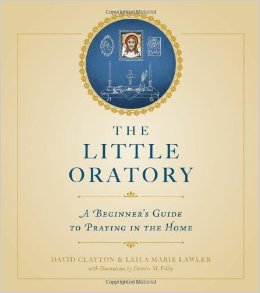A Place for Family Prayer
 Life today is fast-paced and can lead us astray, so we need to slow down sometimes and reset our direction toward God. The best way to begin this reorientation is by making space – both physically and spiritually – for prayer in the home.
Life today is fast-paced and can lead us astray, so we need to slow down sometimes and reset our direction toward God. The best way to begin this reorientation is by making space – both physically and spiritually – for prayer in the home.
This is the message of the book The Little Oratory: A Beginner’s Guide to Praying in the Home, published by Sophia Institute Press. Written by David Clayton and Leila Marie Lawler, with simple yet attractive illustrations by Deirdre M. Foley, the book is a how-to manual for setting up a prayer space, as well as a practical guide on how to begin or enhance your family’s prayer routine.
Born in England, author Clayton converted to Catholicism in 1993 and is now artist-in-residence and a fellow at Thomas More College in Merrimack, N.H. Kellie Mason of Fathers for Good contacted him for this interview.
FFG: How will a family benefit from having a little oratory in the home?
Clayton: In a number of ways. For children to have this visual focus for prayer means that they can see that dad or mom or both are praying. They come to associate the orientation of the whole person with prayer. It becomes a physical action as well as something that is said. Also, my 2-year old is already mimicking us and whenever she sees a statue or painting of Christ she recognizes it points and says “Jesus!”
When dad leads the prayers, especially if he is able to do some simple chanting as well, then it reinforces the idea, again through a physical demonstration, that he is the head of the family “as Christ is head of the Church,” (Ephesians 5:23) that is the advocate to God for them. His special role as provider and protector includes pray-er, that is, the one who prays for all. I believe that as well as allowing supernaturally the father to feel more fulfilled in his role, this will have lessons for children as well. It will reinforce the idea that prayer is a masculine thing as well as a feminine thing.
The crisis of fatherhood is in part due, I believe, to our having forgotten this aspect of there being a form of prayer that is intrinsically masculine. Seeing dad in front of the family, facing Christ and asking for blessings for all, will inspire boys to be good fathers when they grow up and also encourage vocations to the priesthood, because the father is playing a quasi-priestly role here that is an echo of what the priest in church is doing.
FFG: What advice do you have for young families creating their first little oratory?
Clayton: Our book describes the principles for the ideal. It has eight color icons in standard sizes that you can frame very cheaply and explains the usual set up. It also has ideas on how you make it visible but discreet, so visitors don’t feel that you are doing the visual equivalent of shouting at them with a megaphone! But also it anticipates the practical difficulties, such as how high, what else do you put on there, what can you change according to the year so that it reinforces the cycles of the liturgical seasons and keeps the children interested?
FFG: What about those families who have little time or physical space for this program?
Clayton: In doing all of this there is one thing to keep in mind. You don’t have to do everything! You start small and where you are and do things gradually.
It is good also to be aware of a hierarchy of prayer. The book explains, especially in regard to praying at home, what are the most important things, what are least important, so you know what to drop if you are busy or how to substitute.
FFG: What is the main message you want to convey?
Clayton: A number of things. You have heard of St Therese of Lisieux and her Little Way, in which she strove to make every ordinary action in life one ordered to love of God and man. Well this is similar, but it is the Little Way of Beauty!
I discovered this tradition by investigating how artists were trained to apprehend beauty and be open to God’s inspiration.? I realized that while it did give this to artists, in fact artists were just doing what many did in that time because every person can benefit from God’s grace and by trying to do things beautifully. If we try to do the little acts beautifully as well as lovingly then the radiance of it will strike others and draw them into the faith. This is the New Evangelization.
This book is really a manual for the New Evangelization – by the traditional prayer that it describes, we are personally transformed and through every single one of our personal relationships whether deep or superficial we can have a profound effect on others. This will be most likely one that we are unaware of ourselves. We just do things more lovingly and beautifully despite ourselves and this is noticed at some level by those we deal with.
For more information, visit the Sophia Institute website.

